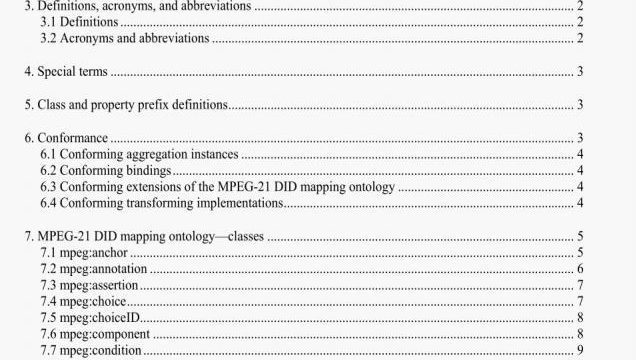Digital Item Declaration mapping to the conceptual model for resource aggregation
AS 1484.13.3-2020 pdf download.Recommended practice for learning technology— ISO 21 000-2:2005 Information technology — Multimedia framework (MPEG-21), Part 2: Digital Item Declaration mapping to the conceptual model for resource aggregation.
6.1 Conforming aggregation instances
A conforming aggregation instance shall he an instance of an aggregation format that should be modeled or described in terms of the MPEG-2 1 DID mapping ontology, either as a core ontology representation (mapped from an MPEO-21 DID instance to a core ontology representation) or as an MPEG-2l DID instance (mapped from a core ontology representation to an MPEG-21 DID instance) following the intentions of the MPEG-2 I DID mapping ontology as expressed in Clause 7, Clause 8. and Clause 9 of this recommended Practice.
6.2 Conforming bindings
Conforming bindings of the MPEG-21 DID mapping ontology
— Should conform to the requirements of Clause 7. Clause X. and Clause 9 of this recommended practice.
— If the binding technology language supports Uniform Resource Identifiers (URIs). then it shall use the same URIs as those in the Terse RDF Triple Language (Turtle) representation referenced in Annex D of this recommended practice.
If the binding technology language supports Uniform Resource Identifiers (URIs) and the binding contains extensions to the MPEG-21 l)ID mapping ontology (sec 6.4). then identifiers for the extensions shall be defined in a new namespace.
6.3 Conforming extensions of the MPEG-21 DID mapping ontology
The MPEG.2l DID mapping ontology may be extended for a conformant MPEG-21 DID aggregation format extension that relates to interpreting externalized representations oldigital aggregations by adding a new class or property and defining a new identifier in a new mapping ontology. The new identifier shall not be used to identify a concept that already exists in the MPEG-2 1 DID mapping ontology. Bindings for contorming extensions shall conform to the requirements in 6.2.
NOTE—Concepts relating to irnerprelrng externalized representations of digital aggregations should be defined as confonuing extensions to the MPFG-21 DII) mapping ontology. Other concepts may be represented by other vocabubrie5 cc ontologics and combined with the MPEG.21 DID mapping ontology using standard Semantic Web practices.
6.4 Conforming transforming implementations
7. MPEG-21 DID mapping ontology—classes
This clause provides declarations of all the classes in the MPEG-21 DID mapping ontology. The
declarations use the following format:
— Class name: The name of the class in the MPEC-2I DID mapping ontology.
— Mapped from: A RAMLET-allocated identifier representing the name (including capitalization) of the element or attribute in the MPE(i-21 DID aggregation format. This identifier is expressed as a Uniform Resource Identifier (URI). which may not resolve at the fragment level.
— Maps: A description of the elements or attributes mapped from the MPE(i-2 I DID aggregation format.
— Mapped to: The core ontology class to which the MPFG-2l DID mapping ontology class maps. (See IEEE Std 1484.13.1-2012.)
— Scope note: A textual description of the class. Scope notes are reproduced directly from the descriptions of the MPEG elements and attributes in ISO1EC 21000-2:2005. For additional clarification of any of the ternis in the scope notes please consult ISOIEC 21000-2:2005.
— Data type: The data type of the MPEG-2 I DID mapping ontology class as defined in Clause 9.
— Properties: The properties of the MPEG-2 I DID mapping ontology class as defined in Clause 8. Inherited properties are not included in the entry.
— Asserted conditions; Any conditions that are asserted for the MPEG-2l DID mapping ontology class as a result of its properties.
7.1 mpeg:anchor
Class name: mpeg:anchor
Mapped from: http:standards.iso.org/iso-iec2 l000/-2Jed-2Jen#Anchor
Maps: The anchor entity of the information model; <Anchor> element of the representation.
Mapped to: ramlct:anchor
Scope note: An anchor binds descriptors to a fragment. which corresponds to a specific location or range within a resource.
Properties: ramlet:includes someValuefrom mpeg:fragmcnm
ramlet:includes allValuesFrorn mpeg:condition. mpeg:descriptor, mpeg;fragment.
mpeg:identifier. mpeg:precedence.AS 1484.13.3-2020 pdf download.
Digital Item Declaration mapping to the conceptual model for resource aggregation
